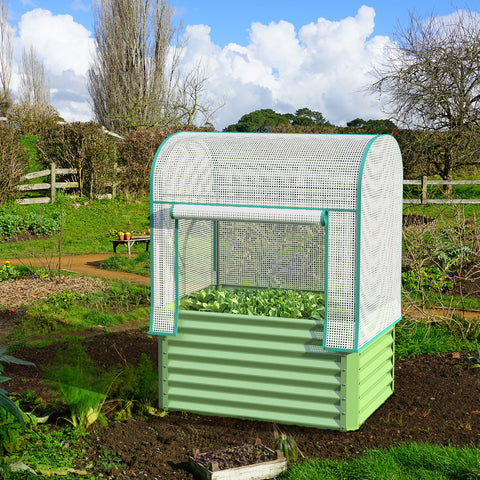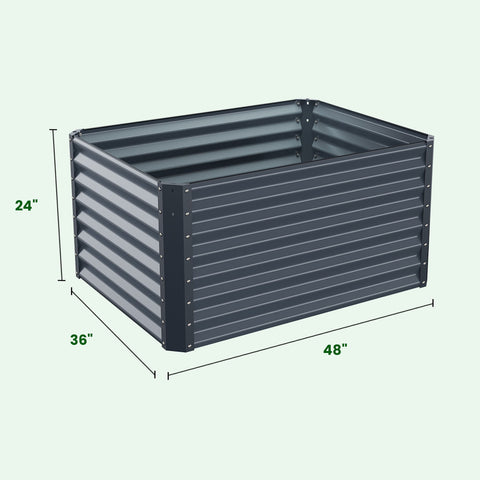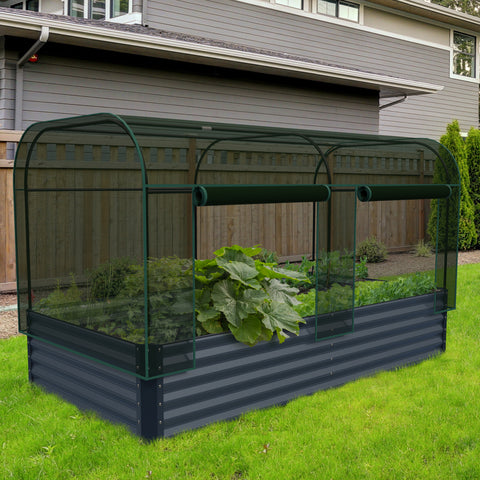When it comes to gardening, one of the biggest concerns for many home gardeners is how to protect plants from the elements. One option some gardeners consider is to put a greenhouse in their garden bed. But is it a good idea? In this article, we will explore whether you can put a greenhouse on your garden and what benefits this might have for your plants.The following content also has some reference value for raised garden beds.
You could put a greenhouse in the garden. This has several benefits, such as providing extra protection for your plants, extending the growing season, and creating a more controlled year-round environment for your plants.
However, there are some potential downsides to consider, such as the cost of building or buying your own greenhouse and the amount of work involved in maintaining it. Before you decide to put a greenhouse in your garden bed, be sure to weigh the pros and cons carefully to see if this is the right solution for you and your plants.

Can I build a greenhouse in my garden bed?
Greenhouse kits are a great way to support your garden bed! By using a kit, you don't have to buy materials or worry about whether you have all the necessary supplies. You can also leave the planning to the manufacturer, as the kit comes with specific instructions on how to put the greenhouse together. It helps, especially if you're new to gardening.
You also often get additional support from the manufacturer when you buy kits. For example, some companies offer a customer service hotline that you can call if you have any queries or questions. If you're thinking about installing a greenhouse on your garden bed, a greenhouse kit is definitely worth considering.
What is the difference between an elevated greenhouse and an elevated bedspread?
Elevated bed greenhouses and elevated bed covers are both great options for gardening in small Spaces.
Elevated bed greenhouses are usually made of metal or plastic and have a clear lid that allows sunlight to reach the plants inside. Raised bed covers, on the other hand, are usually made of fabric or mesh and only cover the top of the raised bed.

Both types of products have their own advantages and disadvantages, so it's important to choose the one that suits your needs. Elevated bed greenhouses are more expensive than elevated bed covers, but they offer better protection from pests and extreme weather. Raised bed covers are cheaper and easier to install, but they don't offer enough protection.
Raised bed type greenhouses are usually taller than raised bedspreads and have ventilation openings to ensure proper air circulation. The raised bedspread is shorter and has no air vents. Elevated bed greenhouses are commonly used to start plants early in the season or to protect sensitive plants from cold weather, while elevated bed covers are most often used to protect plants from pests and diseases.
Should I install a greenhouse or lid on my garden bed?
If you're looking for a way to protect your garden from the elements, a high-bed greenhouse could be the perfect solution for you. This type of greenhouse is taller than a raised bedspread and features ventilation openings to ensure proper air circulation and provides better protection from pests and extreme weather. A high-bed greenhouse is a great option for gardeners who want to start planting early in the season or protect sensitive plants from cold weather.
If you're looking for a cheaper option, a raised bed cover might be a better choice for you. This type of cover is shorter than a loft bed greenhouse, has no vents, and provides pest and disease protection. Raised bed covers are a great option for gardeners who want to protect their plants from the elements.
Can I put a greenhouse anywhere in the garden?
You can place the greenhouse anywhere in the garden, as long as there is plenty of sunlight and plenty of space. However, there are some areas that are more suitable for greenhouse gardening than greenhouse gardening
If you have a particularly shady garden, for example, then placing the greenhouse in a sunny location will create a perfect microclimate for plants that need a lot of light. Also, if you live in a very cold climate, then having your greenhouse near your house can help you stay warm during the winter.
Finally, it is important to consider the needs of the plants and the climate of the garden before deciding where to put the greenhouse.
Can a greenhouse protect plants from the cold?
If you're considering building a greenhouse, one of your main concerns may be how well it protects your plants from the cold.
The good news is that greenhouses can provide an ideal environment to keep plants healthy and happy during the winter months. By absorbing heat from the sun, greenhouses create a warm and humid environment that is perfect for delicate plants.

In addition, the greenhouse provides shelter from strong winds and heavy snow. As long as you pay attention to ventilation on warm days and provide adequate insulation, your plants should be able to thrive throughout the winter.
Greenhouses can be made from a wide variety of materials, including glass, plastic, and even recyclable materials like metal food jars. If you have a glass or plastic greenhouse, it will not protect your plants from freezing if the temperature outside is cold enough.
However, if you have a metal greenhouse, it will help insulate the inside and keep your plants warm. As a general rule, the thicker the walls of a greenhouse, the better at keeping plants warm during the winter.
Will the greenhouse burn my plants?
While greenhouses do get very warm, especially on sunny days, this heat is usually not enough to damage most plants. However, there are some conditions that can make a greenhouse too hot for plants, such as temperatures inside the greenhouse exceeding 100 degrees Fahrenheit.
If this happens, the plant's leaves will begin to wilt and may even suffer sunburn. To avoid this, make sure to ventilate the greenhouse on hot days and provide shade for plants that are particularly sensitive to heat. With a little care, you can enjoy healthy plants in your greenhouse all summer long.
How to build an overhead bed greenhouse
Raised beds are a great way to garden, providing good drainage and easy access to plants. But what if you want to extend the growing season? Or protect your plants from pests? Greenhouse frames are a good choice. Building a greenhouse frame is very simple, an excellent way to save money and can be done with only a few basic tools. Here is an overview of how to build a greenhouse framework.
Selection of materials
The most important part of the greenhouse is the frame, so it's important to choose materials strong enough to support the weight of the glass or plastic panels. One option is to use PVC pipe, which can be cut to size and fitted together using PVC connectors. Another option is to use metal tubes, which will be more durable but require some welding. If you're not sure which materials to use, check with an employee at your local hardware store. 2 x 4 wood is also a very popular choice - just make sure it is properly treated if it is going to be outside in the weather, or if it comes into contact with your soil.
Measure your garden area
Measure the area you want to build the greenhouse and add a few inches on each side in order to account for the frame. This will give your greenhouse frame the size you will need. Your local hardware store may offer cutting services that can easily get your materials ready.
If you wish to place your greenhouse structure on top of an existing structure, leave a little wiggle room between your DIY greenhouse frame and the garden bed. Your greenhouse design needs to take into account the size of garden beds and sunlight.

Assembly frame
Once you have your materials, it's time to start assembling the frame. Make sure that the fixtures you use match the material of your choice - PVC pipes can be held together with PVC cement, metal pipes can be soldered, and wood can be screwed or nailed in place. It is also important to check that the fix is weatherproof, rust-proof or otherwise able to protect from the elements.
Cover the frame
Once the frame is assembled, you can begin installing the panels. If you are using glass or plastic sheeting, it is important to use clamps or hinges to hold them in place, as they will not be able to support their own weight. Make sure no wind gets through the gaps between the panels - if it does, your plants will be very unhappy









